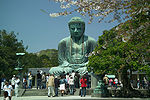List of World Heritage Sites in Japan
The United Nations Educational, Scientific and Cultural Organization (UNESCO) World Heritage Sites are places of importance to cultural or natural heritage as described in the UNESCO World Heritage Convention, established in 1972.[1] Cultural heritage consists of monuments (such as architectural works, monumental sculptures, or inscriptions), groups of buildings, and sites (including archaeological sites). Natural features (consisting of physical and biological formations), geological and physiographical formations (including habitats of threatened species of animals and plants), and natural sites which are important from the point of view of science, conservation or natural beauty, are defined as natural heritage.[2] Japan accepted the UNESCO World Heritage Convention on 30 June 1992.[3]
There are 26 sites listed in Japan, with a further four sites on the tentative list.[3] Japan's first entries to the list took place in 1993 when four sites were inscribed. The most recent site, the Sado mine, was listed in 2024. Among the sites, 21 are listed for their cultural and five for their natural significance.[3] One site is transnational: The Architectural Work of Le Corbusier is shared with six other countries.[4] Japan has served on the World Heritage Committee four times.[3]
World Heritage Sites
[edit]UNESCO lists sites under ten criteria; each entry must meet at least one of the criteria. Criteria i through vi are cultural, and vii through x are natural.[5]
| Site | Image | Location (prefecture) | Year listed | UNESCO data | Description |
|---|---|---|---|---|---|
| Buddhist Monuments in the Hōryū-ji Area | 
|
Nara | 1993 | 660; i, ii, iv, vi (cultural) | This site comprises 48 Buddhist monuments in the Hōryū-ji (pictured) and Hokki-ji temple areas. Some of the buildings date to the 7th and 8th centuries. They were constructed shortly after the introduction of Buddhism to Japan and are among the oldest surviving wooden buildings in the world. The architecture of the monuments reflects the adaptation of Chinese influences and the subsequent development of a distinct Japanese style.[6] |
| Himeji-jō | 
|
Hyōgo | 1993 | 661; i, iv (cultural) | Himeji Castle is the best example of the early 17th century Japanese castle architecture. The complex comprises keeps, walls, and connecting structure. It is made of wood and white plastered earthen walls. The characteristic feature of the main keep are the multiple roof layers. Even if the complex has undergone several repair campaigns, the integrity of the main features has remained intact.[7] |
| Yakushima | 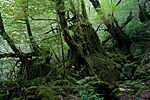
|
Kagoshima | 1993 | 662; vii, ix (natural) | Yakushima is an island about 60 km (37 mi) south of Kyushu. Due to its location and the fact that it has mountains reaching almost to 2,000 m (6,600 ft) above sea level, it has a vertical sequence of plant communities that is rare in the Northern Hemisphere. They include subtropical coastal vegetation, montane temperate rainforest, and high moorland and bamboo forest at the highest elevations. The island is rich in biodiversity. There are numerous Japanese cedar trees, some of which are over 1000 years old. About a fifth of the island is protected.[8] |
| Shirakami-Sanchi | 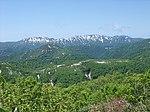
|
Aomori, Akita | 1993 | 663; ix (natural) | The property covers a mountainous area with some of the last and largest remainders of the Japanese beech old-growth forests, a type of forest that used to cover the mountains of northern Japan after the Last Glacial Period. The area is home to Japanese black bear, Japanese macaque, Japanese serow, and black woodpecker.[9] |
| Historic Monuments of Ancient Kyoto (Kyoto, Uji and Otsu Cities) | 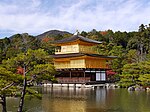
|
Kyoto, Shiga | 1994 | 688; ii, iv (cultural) | Kyoto was the capital of Japan from its founding in 794 to the middle of the 19th century. It was also a cultural centre, crucial for the development of religious and secular architecture, in particular in wood, of the country. The designs of Japanese gardens has had a profound influence worldwide from the 19th century on. The site comprises 17 properties, including Kinkaku-ji (pictured), Ginkaku-ji, Ryōan-ji, and Kiyomizu-dera.[10] |
| Historic Villages of Shirakawa-gō and Gokayama | 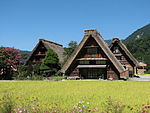
|
Gifu, Toyama | 1995 | 734; iv, v (cultural) | This site comprises three villages in a remote mountain area, where the economy centred around growing of mulberry trees and rearing of silkworms. The villages are characterized by the Gassho-style houses with steeply pitched thatched roofs.[11] |
| Hiroshima Peace Memorial (Genbaku Dome) | 
|
Hiroshima | 1996 | 775; vi (cultural) | The Peace Memorial centres around the ruin of the only building left standing after the detonation of the first atomic bomb above the city of Hiroshima on 6 August 1945. Originally, this was the Hiroshima Prefectural Industrial Promotional Hall, built in 1914. The memorial commemorates the effects of humanity's most destructive weapons and at the same time expresses hope for world peace.[12] |
| Itsukushima Shinto Shrine | 
|
Hiroshima | 1996 | 776; i, ii, iv, vi (cultural) | Itsukushima Shrine is a holy place of Shinto, an ancient Japanese religion that centres on polytheistic nature worship. The shrine was founded by the military leader Taira no Kiyomori in the 13th century. The architecture reflects the styles of the late 12th and early 13th centuries, and even if the complex has been reconstructed twice, it preserves the original styles. A notable feature of the shrine is its setting on the coast with mountains in the background, which results in scenic beauty.[13] |
| Historic Monuments of Ancient Nara | 
|
Nara | 1998 | 870; ii, iii, iv, vi (cultural) | Nara was the capital of Japan during the Nara period between 710 and 784, a period of profound political and cultural changes. This site comprises five Buddhist temples (Kōfuku-ji pictured), a Shinto shrine, the remains of the Nara Palace, and the surrounding cultural landscape with the Kasugayama Primeval Forest. The monuments demonstrate cultural influences from China and Korea on subsequent developments of styles.[14] |
| Shrines and Temples of Nikkō | 
|
Tochigi | 1999 | 913; i, iv, vi (cultural) | The sacred mountains of Nikkō have more than a hundred Buddhist and Shinto religious buildings. The first were constructed in the 8th century and many date to the 17th century. The layout of the complex follows the Shinto perception of interactions between man and the nature. The buildings are associated with important chapters of Japanese history and feature numerous artworks. The carving of three wise monkeys at the Nikkō Tōshō-gū shrine, dedicated to Tokugawa Ieyasu, is pictured.[15] |
| Gusuku Sites and Related Properties of the Kingdom of Ryukyu | 
|
Okinawa | 2000 | 972; ii, iii, vi (cultural) | The group of monuments dates from the Ryukyu Kingdom period, from 12th to 17th centuries. The characteristic feature of the period are gusuku. fortified castles that developed from earlier stone enclosures around villages. The islands maintained trade and cultural connections with Japan, China, Korea, and south-east Asia, which is reflected in the monuments. Five gusuku sites, two related monuments, and two related cultural landscapes are listed. Shuri Castle is pictured.[16] |
| Sacred Sites and Pilgrimage Routes in the Kii Mountain Range | 
|
Wakayama, Nara, Mie | 2004 | 1142bis; ii, iii, iv, vi (cultural) | The mountains of the Kii Peninsula have sacred sites for Buddhism and Shinto religions and there is a well-documented tradition of sacred mountains spanning over 1200 years. A network of pilgrimage routes, shrines, and temples shape the cultural landscape. The architecture of the religious sites influenced sites in other parts of the country. A temple on the top of Mount Kōya is pictured. A minor boundary modification took place in 2016.[17] |
| Shiretoko | 
|
Hokkaido | 2005 | 1193; ix, x (natural) | This site comprises part of the Shiretoko Peninsula and the surrounding marine area. Sea ice occurs in winter at the lowest latitude in the Northern Hemisphere. Highly productive seas supply the complex food webs and sustain a number of marine and terrestrial species. The area is home to Steller's sea eagle (pictured), Blakiston's fish owl, Japanese black bear, as well as several species of salmonid fish, seals, and cetaceans.[18] |
| Iwami Ginzan Silver Mine and its Cultural Landscape | 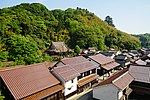
|
Shimane | 2007 | 1246bis; ii, iii, v (cultural) | The Iwami Ginzan was a large silver mine that was active between the 16th and 20th centuries. During the Age of Discovery, silver contributed to a substantial exchange between Japan and countries in Asia and Europe, while the political isolation during the Edo period prevented the introduction of the mining techniques developed in Europe during the Industrial Revolution. Mining focused on small-scale labour-intense units. The remains of mining settlements (Ōmori Ginzan village pictured), smelting and refining sites, and ports to transport the ore have been preserved. A minor boundary modification of the site took place in 2010.[19] |
| Hiraizumi – Temples, Gardens and Archaeological Sites Representing the Buddhist Pure Land | 
|
Iwate | 2011 | 1277rev; ii, vi (cultural) | Hiraizumi was the administrative centre of the realm of the Northern Fujiwara clan in the 11th and 12th centuries. The realm rivaled Kyoto commercially and politically, but much of the area was destroyed in 1189 after Hiraizumi lost its political status. The site comprises four gardens and the area of the Mount Kinkeizan. The gardens follow the concepts of Pure Land Buddhism, representing the pure land of Buddha. The design was also influenced by the native Shinto religion and in turn influenced temples in other parts of Japan. Mōtsū-ji is pictured.[20] |
| Ogasawara Islands | 
|
Tokyo | 2011 | 1362; ix (natural) | The Ogasawara Archipelago is a group of around 30 islands located in the north-western Pacific Ocean around 1,000 km (620 mi) off the Japanese mainland. Because of its isolation, the islands have high number of endemic species and are important for studies of ongoing evolutionary processes and speciation. The islands are home to 195 endangered bird species, the critically endangered Bonin flying fox, and over four hundred native plant taxa. The surrounding waters support numerous species of fish, cetaceans, and corals.[21] |
| Fujisan, sacred place and source of artistic inspiration | 
|
Shizuoka, Yamanashi | 2013 | 1418; iii, vi (cultural) | Mount Fuji is a solitary stratovolcano with the height of 3,776 m (12,388 ft). The scenic beauty of the often snow-capped mountain has served as an inspiration for artists through centuries, especially for the woodblock prints of Hokusai, which had a profound influence on Western art. The mountain is also sacred in the Buddhist and Shinto traditions and there are numerous pilgrimage paths and shrines on the mountain slopes.[22] |
| Tomioka Silk Mill and Related Sites | 
|
Gunma | 2014 | 1449; ii, iv (cultural) | Tomioka Silk Mill illustrates the transition of Japan into a modern industrialized era in the late 19th and early 20th centuries. During the early Meiji era, the government brought French machinery and expertise to a region with traditional ties to silk production in order to start industrial production. This made Japan a major world exporter of raw silk. It also made Tomioka a centre of technological innovation.[23] |
| Sites of Japan's Meiji Industrial Revolution: Iron and Steel, Shipbuilding and Coal Mining | 
|
several sites | 2015 | 1484; ii, iv (cultural) | During the Meiji era of the second half of the 19th century, Japan developed industry, such as iron and steel production, shipbuilding, and coal mining, with technology transfer from Europe and America. This made Japan the first example of a successful transfer of Western industrialization to a non-Western nation and turned Japan into a world-level industrial power, as well as profoundly changing its society. This site comprises 23 components in eight areas, six of which are in the south-eastern part of the country. Miike coal mine is pictured.[24] |
| The Architectural Work of Le Corbusier, an Outstanding Contribution to the Modern Movement* | 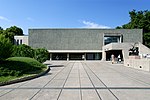
|
Tokyo | 2016 | 1321rev; i, ii, vi (cultural) | This transnational site (shared with Argentina, Belgium, France, Germany, Switzerland, and India) encompasses 17 works of Franco-Swiss architect Le Corbusier. Le Corbusier was an important representative of the 20th-century Modernist movement, which introduced new architectural techniques to meet the needs of the changing society. The National Museum of Western Art (pictured) is listed in Japan.[4] |
| Sacred Island of Okinoshima and Associated Sites in the Munakata Region | 
|
Fukuoka | 2017 | 1535; ii, iii (cultural) | The island of Okinoshima, located 60 km (37 mi) off the north-western coast of Kyushu, is worshiped as a sacred island and was a place of rituals associated with maritime safety between the 4th and 9th centuries by people from Japan, Korea, and the Asian continent, during the period of formation of Japanese identity. Votive objects deposited on the island provide insight into how these rituals were changing through time and how the cultural exchange was taking place. The site also comprises properties on Kyushu, where "distant worship" takes place. The Munakata Taisha shrine is pictured.[25] |
| Hidden Christian Sites in the Nagasaki Region | 
|
Nagasaki, Kumamoto | 2018 | 1495; iii (cultural) | This site comprises 12 components related to Christianity in Japan. Although the religion was banned during the Edo period between the 17th and 19th centuries, hidden Christian communities survived in small villages in the northwestern part of Kyushu. They gave rise to a specific tradition that appeared vernacular but kept the ideas of the Christian faith. When the ban was lifted in 1873, Christian communities saw revitalization. The Ōura Church is pictured.[26] |
| Mozu-Furuichi Kofungun, Ancient Tumulus Clusters | 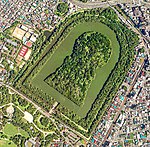
|
Osaka | 2019 | 1593bis; iii, iv (cultural) | This site comprises 49 burial mounds, called kofun. There are over 160,000 such tombs in Japan and the selected ones are the most representative. They date to the Kofun period from the 3rd to the 6th centuries. These mounds have geometric shapes, such as keyhole, square, or circle. Some have moats around them and several contained grave goods and clay figure decorations. Daisen-Kofun in Osaka is pictured. A minor boundary modification of the site took place in 2023.[27] |
| Amami-Ōshima Island, Tokunoshima Island, northern part of Okinawa Island, and Iriomote Island | 
|
Kagoshima, Okinawa | 2021 | 1574; x (natural) | This site comprises protected areas in four islands, Amami Ōshima, Iriomote, Tokunoshima, and northern part of Okinawa Island. The islands became separated from the mainland in the late Miocene epoch, resulting in isolation of terrestrial species that have since formed a unique biota, rich in biodiversity. Endemic species include the Okinawa rail (pictured), Iriomote cat, Amami rabbit, and Ryukyu long-tailed giant rat.[28] |
| Jōmon Prehistoric Sites in Northern Japan | 
|
Hokkaidō, Aomori, Iwate, Akita | 2021 | 1632; iii, v (cultural) | This site comprises 17 archaeological sites from the Jōmon period, spanning roughly from 13,000 BCE to 400 BCE. The Jōmon people were a sedentary society that practiced hunter-gathering and fishing in a resource-rich environment. They developed pottery and created particular ceramic figures called dogū. Archaeological remains include earthen mounds, stone circles, and ritual deposits. A reconstruction of a settlement at the Sannai-Maruyama Site is pictured.[29] |
| Sado Island Gold Mines | 
|
Niigata | 2024 | 1698; iv (cultural) | This site comprises heritage of gold and silver mines on the Sado Island over 250 years during the Tokugawa shogunate. The island is of a volcanic origin and has gold and silver either in veins or in placer deposits. They were extracted using non-mechanized traditional techniques. People working in the mines came from all parts of Japan and formed their unique culture.[30][31] |
Tentative list
[edit]In addition to sites inscribed on the World Heritage List, member states can maintain a list of tentative sites that they may consider for nomination. Nominations for the World Heritage List are only accepted if the site was previously listed on the tentative list.[32] Japan maintains four properties on its tentative list.[3]
See also
[edit]- Cultural Properties of Japan
- National Treasures of Japan
- Cultural Landscapes of Japan
- National parks of Japan
References
[edit]- ^ "The World Heritage Convention". UNESCO World Heritage Centre. Archived from the original on 27 August 2016. Retrieved 21 September 2010.
- ^ "Convention Concerning the Protection of the World Cultural and Natural Heritage". UNESCO World Heritage Centre. Archived from the original on 1 February 2021. Retrieved 3 February 2021.
- ^ a b c d e "Japan". UNESCO World Heritage Centre. Retrieved 20 November 2024.
- ^ a b "The Architectural Work of Le Corbusier, an Outstanding Contribution to the Modern Movement". UNESCO World Heritage Centre. Archived from the original on 24 November 2018. Retrieved 10 December 2020.
- ^ "UNESCO World Heritage Centre – The Criteria for Selection". UNESCO World Heritage Centre. Archived from the original on 12 June 2016. Retrieved 17 August 2018.
- ^ "Buddhist Monuments in the Horyu-ji Area". UNESCO World Heritage Centre. Retrieved 14 December 2023.
- ^ "Himeji-jo". UNESCO World Heritage Centre. Retrieved 14 December 2023.
- ^ "Yakushima". UNESCO World Heritage Centre. Retrieved 14 December 2023.
- ^ "Shirakami-Sanchi". UNESCO World Heritage Centre. Retrieved 14 December 2023.
- ^ "Historic Monuments of Ancient Kyoto (Kyoto, Uji and Otsu Cities)". UNESCO World Heritage Centre. Retrieved 14 December 2023.
- ^ "Historic Villages of Shirakawa-go and Gokayama". UNESCO World Heritage Centre. Retrieved 14 December 2023.
- ^ "Hiroshima Peace Memorial (Genbaku Dome)". UNESCO World Heritage Centre. Retrieved 14 December 2023.
- ^ "Itsukushima Shinto Shrine". UNESCO World Heritage Centre. Retrieved 14 December 2023.
- ^ "Historic Monuments of Ancient Nara". UNESCO World Heritage Centre. Retrieved 14 December 2023.
- ^ "Shrines and Temples of Nikko". UNESCO World Heritage Centre. Retrieved 14 December 2023.
- ^ "Gusuku Sites and Related Properties of the Kingdom of Ryukyu". UNESCO World Heritage Centre. Retrieved 14 December 2023.
- ^ "Sacred Sites and Pilgrimage Routes in the Kii Mountain Range". UNESCO World Heritage Centre. Retrieved 14 December 2023.
- ^ "Shiretoko". UNESCO World Heritage Centre. Retrieved 14 December 2023.
- ^ "Iwami Ginzan Silver Mine and its Cultural Landscape". UNESCO World Heritage Centre. Retrieved 14 December 2023.
- ^ "Hiraizumi – Temples, Gardens and Archaeological Sites Representing the Buddhist Pure Land". UNESCO World Heritage Centre. Retrieved 14 December 2023.
- ^ "Ogasawara Islands". UNESCO World Heritage Centre. Retrieved 14 December 2023.
- ^ "Fujisan, sacred place and source of artistic inspiration". UNESCO World Heritage Centre. Retrieved 14 December 2023.
- ^ "Tomioka Silk Mill and Related Sites". UNESCO World Heritage Centre. Retrieved 14 December 2023.
- ^ "Sites of Japan's Meiji Industrial Revolution: Iron and Steel, Shipbuilding and Coal Mining". UNESCO World Heritage Centre. Retrieved 14 December 2023.
- ^ "Sacred Island of Okinoshima and Associated Sites in the Munakata Region". UNESCO World Heritage Centre. Retrieved 14 December 2023.
- ^ "Hidden Christian Sites in the Nagasaki Region". UNESCO World Heritage Centre. Retrieved 14 November 2024.
- ^ "Mozu-Furuichi Kofun Group: Mounded Tombs of Ancient Japan". UNESCO World Heritage Centre. Retrieved 14 November 2024.
- ^ "Amami-Oshima Island, Tokunoshima Island, Northern part of Okinawa Island, and Iriomote Island". UNESCO World Heritage Centre. Retrieved 14 November 2024.
- ^ "Jomon Prehistoric Sites in Northern Japan". UNESCO World Heritage Centre. Retrieved 14 November 2024.
- ^ "Sado Island Gold Mines". UNESCO World Heritage Centre. Retrieved 14 November 2024.
- ^ "Sado Island Gold Mines - Executive summary". UNESCO World Heritage Centre. Retrieved 14 November 2024.
- ^ "Tentative Lists". UNESCO World Heritage Centre. Archived from the original on 24 September 2005. Retrieved 7 October 2010.
- ^ "Temples, Shrines and other structures of Ancient Kamakura". UNESCO World Heritage Centre. Retrieved 7 October 2024.
External links
[edit]- (in Japanese) World Heritage Sites in Japan
- (in Japanese) Database of National Cultural Properties - World Heritage (世界遺産)


